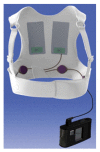Wearable cardioverter defibrillator: Bridge or alternative to implantation?
- PMID: 28706588
- PMCID: PMC5491470
- DOI: 10.4330/wjc.v9.i6.531
Wearable cardioverter defibrillator: Bridge or alternative to implantation?
Abstract
The implantable cardioverter-defibrillator (ICD) is effective to prevent sudden cardiac death (SCD) in selected patients with heart disease known to be at high risk for ventricular arrhythmia. Nevertheless, this invasive and definitive therapy is not indicated in patients with potentially transient or reversible causes of sudden death, or in patients with temporary contra-indication for ICD placement. The wearable cardioverter defibrillator (WCD) is increasingly used for SCD prevention both in patients awaiting ICD implantation or with an estimated high risk of ventricular arrhythmia though to be transient. We conducted a review of current clinical uses and benefits of the WCD, and described its technical aspects, limitations and perspectives.
Keywords: Primary prevention; Secondary prevention; Sudden cardiac death; Ventricular arrhythmias; Wearable cardioverter/defibrillator.
Conflict of interest statement
Conflict-of-interest statement: The authors report no relationships that could be construed as a conflict of interest.
Figures





References
-
- Mozaffarian D, Benjamin EJ, Go AS, Arnett DK, Blaha MJ, Cushman M, Das SR, de Ferranti S, Després JP, Fullerton HJ, et al. Heart Disease and Stroke Statistics-2016 Update: A Report From the American Heart Association. Circulation. 2016;133:e38–360. - PubMed
-
- Moss AJ, Hall WJ, Cannom DS, Daubert JP, Higgins SL, Klein H, Levine JH, Saksena S, Waldo AL, Wilber D, et al. Improved survival with an implanted defibrillator in patients with coronary disease at high risk for ventricular arrhythmia. Multicenter Automatic Defibrillator Implantation Trial Investigators. N Engl J Med. 1996;335:1933–1940. - PubMed
-
- Moss AJ, Zareba W, Hall WJ, Klein H, Wilber DJ, Cannom DS, Daubert JP, Higgins SL, Brown MW, Andrews ML. Prophylactic implantation of a defibrillator in patients with myocardial infarction and reduced ejection fraction. N Engl J Med. 2002;346:877–883. - PubMed
-
- Bardy GH, Lee KL, Mark DB, Poole JE, Packer DL, Boineau R, Domanski M, Troutman C, Anderson J, Johnson G, et al. Amiodarone or an implantable cardioverter-defibrillator for congestive heart failure. N Engl J Med. 2005;352:225–237. - PubMed
-
- Hohnloser SH, Kuck KH, Dorian P, Roberts RS, Hampton JR, Hatala R, Fain E, Gent M, Connolly SJ. Prophylactic use of an implantable cardioverter-defibrillator after acute myocardial infarction. N Engl J Med. 2004;351:2481–2488. - PubMed
Publication types
LinkOut - more resources
Full Text Sources
Other Literature Sources

